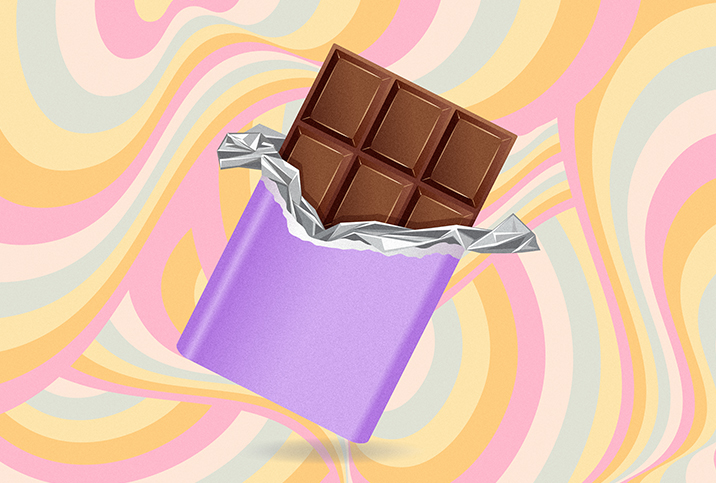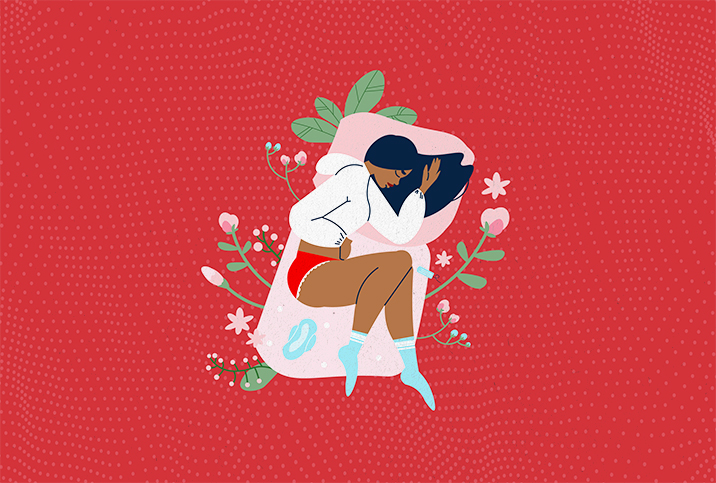Eating Dark Chocolate May Just Ease Your Menstrual Cramps

Cramps and chocolate are a match made in heaven, according to the many pop culture references portraying the dessert as a remedy for painful cramps during menstruation.
But is it just a placebo effect? Have we been inundated with the idea that chocolate improves our periods or is there science behind this treat easing the ache? We talked to the experts to find out.
Dark chocolate or bust
The benefits of eating chocolate come from cacao, the seed from which chocolate is made.
Cramps, or dysmenorrhea, happen when the uterine wall contracts, which can cause pain. The darker the chocolate, the higher the concentration of cacao, which provides the beneficial ingredients that lend themselves to cramp relief.
"It's important to look at the percentage of cacao and the quality of the chocolate. Seventy percent and higher are the best quality because they're the least processed," said De'Nicea Hilton Harper, D.O.M., a doctor of Oriental medicine and health consultant in Clearwater, Florida.
Eating milk chocolate while on your period could worsen cramps if you have a sensitivity to dairy. Even if you're not lactose intolerant, milk chocolate is unlikely to provide any relief because it doesn't have enough cocoa to provide cramp-relieving benefits. Additionally, milk chocolate usually has more sugar than dark chocolate.
"The excess sugar can contribute to cramping because it's inflammatory," Hilton said.
While research is limited, several small studies suggest a positive connection between dark chocolate and period pain reduction. A 2017 study that examined the effect of dark chocolate on menstrual pain in late adolescents indicated there were significant differences in menstrual pain before and after consuming chocolate. The group that ate chocolate had less menstrual pain than the control group that didn't have chocolate.
Authors of a 2019 study published in the International Journal of Physiology concluded: "The pain levels during dysmenorrhoea was significantly reduced by administration of dark chocolate as compared to no administration. The use of a natural substitute is a viable option to NSAIDs [nonsteroidal anti-inflammatory drugs] as it carries none of the side effects associated with the drugs."
The nutrients in dark chocolate do the work
"It's likely that a number of compounds found in dark chocolate play a role [in reducing cramps]," said Alex Polyakov, M.B.B.S., an OB-GYN and associate professor at the University of Melbourne in Australia.
Chocolate has polyphenols, a chemical compound that reduces inflammation and can ease pain from cramps. The potassium in dark chocolate relieves bloating by combating water retention and regulating sodium levels. Dark chocolate is also rich in antioxidants, flavonoids and minerals, such as iron and calcium.
"Calcium may also play a role as it's involved in nerve signal conduction, and the sensation of pain may be affected by inadequate intake," Polyakov explained.
"High concentration of copper present in dark chocolate may be responsible [for reduction of cramps] since copper is an essential ingredient of endorphins, which may have a pain-relieving effect," Polyakov added.
While research is limited, several small studies suggest a positive connection between dark chocolate and period pain reduction.
Chocolate is also an excellent source of magnesium, which has the potential to relax the muscles because it suppresses the prostaglandins that cause contractions in the uterus.
A medium-sized banana has 32 milligrams of magnesium, while 100 grams of dark chocolate contains 176 mg of magnesium. A 100-gram bar of 70 percent to 85 percent dark chocolate contains 58 percent of the recommended daily intake for magnesium.
Low levels of magnesium can result in muscle cramping, so you may want to consider taking a magnesium supplement if you're having a particularly painful period. However, it's important to consult your doctor first because too much magnesium can be dangerous.
Eating chocolate can also just make you feel good. The flavonoids in chocolate promote feel-good endorphins and may even preserve cognitive abilities, according to a 2013 study published in the British Journal of Clinical Pharmacology.
How much chocolate should you eat?
Selecting your chocolate dose is up to you, but try starting small. Eating a small piece is satisfying and effective because it's nutrient-dense, according to Hilton.
A 2015 study published in the Journal of Medicine and Health suggested that 20 grams of dark chocolate a day does the trick. The study tracked the results of subjects eating 20 grams of dark chocolate daily during the two weeks leading up to their menstruation period. A significant decrease was suggested in cramps, bloating and muscle pain when dark chocolate was consumed.
Research is limited, but enjoy your chocolate
The studies that have been conducted on chocolate and cramps are minimal.
"There are some papers that support the role of chocolate in treating menstrual cramps. It must be noted that the studies are small and can only be considered weak scientific evidence," Polyakov said. "None of the studies on this topic are published in high-quality journals and, therefore, must be interpreted with caution."
Still, if you want to eat a piece of chocolate on your period, go for it. Whether it's for easing cramps or satisfying cravings, or it just tastes good, chocolate and periods go hand in hand.


















